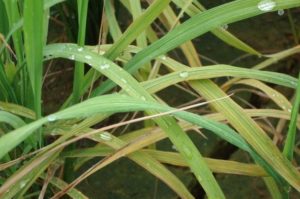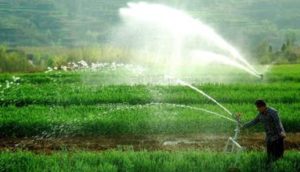Symptoms of Zinc Deficiency in Rice and Fertilization Techniques
Zinc is one of the trace elements necessary for rice growth and development. If rice lack of zinc, the middle veins of the lower leaves will appear chlorotic white spots,  reddish brown spots or irregular plaques, and then there will be reddish brown stripes expanded from the tip down leafs to upper leaves. The new leaves grow rate of diseased leaves were slow, the new leaves were short and narrow, and the leaf color was lighter, especially the basal midvein which will fade into yellowish white. Serious disease plant leaves pillow are shortened or dislocated as well as they have obvious dwarf clusters and their field behavior often are uneven. In addition, roots of serious disease plant are decadent and brown.
reddish brown spots or irregular plaques, and then there will be reddish brown stripes expanded from the tip down leafs to upper leaves. The new leaves grow rate of diseased leaves were slow, the new leaves were short and narrow, and the leaf color was lighter, especially the basal midvein which will fade into yellowish white. Serious disease plant leaves pillow are shortened or dislocated as well as they have obvious dwarf clusters and their field behavior often are uneven. In addition, roots of serious disease plant are decadent and brown.
The application of zinc fertilizer in zinc-deficient paddy fields has a significant effect of increasing yield and improving product quality. But the use of zinc fertilizer is very scientific. Unreasonable fertilization will not only lead to fertilizer waste, but also lead to production reduce. Therefore, we should master the following technical requirements:
- Only suit for zinc-deficient fields. The critical index of available zinc which suit for rice growth in soils is 0.5mg / kg. If the soil can’t achieve to the critical index, we should apply zinc fertilizer to soil.Generally calcareous soil is rich in calcium, and the PH value of such soil also is high. If the effective zinc mixed with carbonate or hydroxide, there will be a chemical reaction taken place. Such action will form zinc carbonate or zinc hydroxide precipitation which will make zinc invalid so that lead to zinc deficiency. Long-term large-scale application of nitrogen, phosphorus fertilizer in paddy fields, effective zinc will be reduced. The above types of rice should increase zinc fertilizer.
- Appropriate application. Most of the zinc fertilizer used in paddy fields is zinc sulfate, usually 1-1.5kg per mu. As the zinc fertilizer has a significant post-effect, so the application of first
 season may still have an influence on the next season. Therefore,zinc fertilizer do not need to use every year, we can apply zinc fertilizer every two to three years.
season may still have an influence on the next season. Therefore,zinc fertilizer do not need to use every year, we can apply zinc fertilizer every two to three years. - Zinc fertilizer application should be early. Applying zinc fertilizer to seedling field is a good way to promote fertilizer utilization rate. Zinc fertilizer can be applied and sprayed.
- Application should be average. In order to make zinc fertilizer evenly, zinc fertilizer can be mixed with physiological and acidic fertilizer. But zinc fertilizer should not be mixed with phosphate fertilizer, otherwise, there will generate zinc phosphate which will reduce fertilizer efficiency and inhibit the rice growth.
-
Foliage spray concentration should be appropriate. Zinc fertilizer for foliage fertilizer is the main method of top dressing, the appropriate zinc sulfate solution concentration is 0.1% -0.2%. Zinc fertilizer spray in seedling should be stared when plant on the stage of transplanted seedlings or 10-15 days after transplanting. In this time, spraying zinc fertilizers 2-3 times continuously is suitable.
Previous: The Role of Intelligent Soil Testing and Fertilizer Machine in Agriculture
Next: The Method of Pesticides Mixture of Flower
